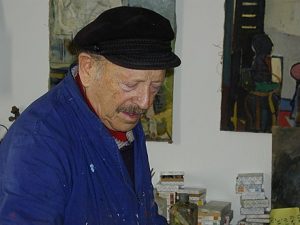Moshe Rosenthalis
 Moshe Rosenthalis (1922-2008) was an artist and teacher of Judeo-Lithuanian-Israeli art. He first became famous for the artwork that he presented for his diploma in 1950 when he graduated from the Academy of Art in Vilna. He was renowned for the bright colors in his artwork, the variety of techniques he used and his never-ending search for ways to innovate his painting style. From 1978-80 he painted a series of pictures entitled Korot Am Yisrael (History of the Jewish people) which is the largest series of the history of the Jewish nation ever painted. He was born in Mariampol, Lithuania. His father was a prosperous merchant and he was the eldest of three sons. He began drawing from a very early age. Having graduated from the Hebrew school in Mariampol, he spoke Hebrew fluently. He fled to Russia, along with thousand of others, when the Nazi German invasion of Soviet territories began. His family suffered severely during the war and he was injured in battle while serving in the Lithuanian brigade of the Red Army as an artist.
Moshe Rosenthalis (1922-2008) was an artist and teacher of Judeo-Lithuanian-Israeli art. He first became famous for the artwork that he presented for his diploma in 1950 when he graduated from the Academy of Art in Vilna. He was renowned for the bright colors in his artwork, the variety of techniques he used and his never-ending search for ways to innovate his painting style. From 1978-80 he painted a series of pictures entitled Korot Am Yisrael (History of the Jewish people) which is the largest series of the history of the Jewish nation ever painted. He was born in Mariampol, Lithuania. His father was a prosperous merchant and he was the eldest of three sons. He began drawing from a very early age. Having graduated from the Hebrew school in Mariampol, he spoke Hebrew fluently. He fled to Russia, along with thousand of others, when the Nazi German invasion of Soviet territories began. His family suffered severely during the war and he was injured in battle while serving in the Lithuanian brigade of the Red Army as an artist.
Rosenthalis was educated at the Academy of Plastic Arts in Vilna. While he was a student the dominant style was "socialist realism". The method of teaching was purely academic- based on dry, precise sketches of nature. However, he was fortunate to study under some of the great Lithuanian artists who had been educated in the tradition of the French school of painting at the beginning of the 20th century. He always said that those artists provided him with a solid background for his future development. He graduated from the Academy with honors; the prize was the purchase of his painting, "The release of prisoners from the prison at Kaunas", as a result of which he was accepted into the Lithuanian Association of Artists and Sculptors. While he was a student he earned his living by drawing posters and illustrating pamphlets and books.
Despite his great successes in the U.S.S.R, he decided to take advantage of his wife's right to return to Poland. He moved to Warsaw with his family in 1957; it was there that he first learnt about abstract painting. At that time Poland was more open to Western culture than the other socialist countries and, according to Rosenthalis, the art there was "totally abstract and very strong". This first meeting with abstract art shocked him deeply and prepared him for his encounter with modern Israeli art, an encounter that would gradually influence the way he worked.
When he arrived in Israel in 1958 he encountered the style of Israeli modernism in painting; its main focus was on the lyrical school of "New Horizons" which was then at its peak. He began to teach to earn a livelihood and, at the same time, was accepted into the Israeli Association of Artists. At first he found it difficult to switch from the socialist realism he had just left to the abstract art that would open the doors to the exclusive club. As he traveled around Israel he learnt to distinguish between the dark scenery of the past with its grey skies and northern elements and the new scenery awash with bright, dazzling light. He understood that he did not have to take any shortcuts in order to reach his goal: to join the club and become a member of the Israeli artists' colony as quickly as possible. He continued to tread the long road from Vilna to Tel Aviv, step by step.
From: Wikipedia



